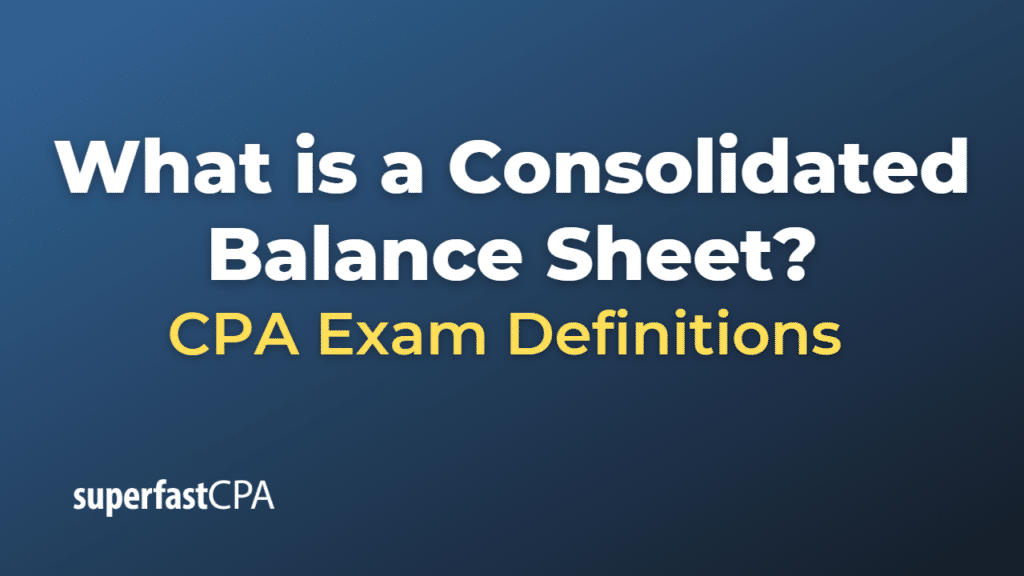Consolidated Balance Sheet
A consolidated balance sheet is a financial statement that presents the combined financial position of a parent company and its subsidiaries as if they were a single entity. It is an essential part of consolidated financial statements, which are prepared by companies with one or more subsidiaries to provide a comprehensive view of the entire group’s financial health.
The purpose of a consolidated balance sheet is to show the combined assets, liabilities, and shareholders’ equity of the parent company and its subsidiaries, eliminating any intercompany transactions and balances between the entities. This helps investors, creditors, and other stakeholders assess the overall financial position of the group, rather than looking at each entity separately.
The process of preparing a consolidated balance sheet involves:
- Combining the balance sheets of the parent company and its subsidiaries line by line, adding together the corresponding assets, liabilities, and equity items.
- Eliminating any intercompany transactions and balances, such as loans, payables, receivables, and investments between the parent company and its subsidiaries.
- Allocating the parent company’s investment in each subsidiary to the subsidiary’s assets, liabilities, and equity based on the parent’s ownership percentage.
- Adjusting any non-controlling interests, which represent the portion of a subsidiary’s equity not owned by the parent company, and including them as a separate component of shareholders’ equity on the consolidated balance sheet.
The consolidated balance sheet provides a more comprehensive view of a group’s financial position than individual balance sheets of the parent company and its subsidiaries. This enables stakeholders to better understand the group’s overall financial strength, liquidity, and solvency, and make informed decisions about investing, lending, or conducting business with the group.
Example of a Consolidated Balance Sheet
Let’s consider a hypothetical example to illustrate the concept of a consolidated balance sheet:
Parent Company A owns 100% of Subsidiary B and 80% of Subsidiary C. The balance sheets of the three companies as of December 31, 20XX, are as follows:
Parent Company A:
- Assets: $1,000,000
- Liabilities: $600,000
- Shareholders’ Equity: $400,000
Subsidiary B:
- Assets: $500,000
- Liabilities: $300,000
- Shareholders’ Equity: $200,000
Subsidiary C:
- Assets: $800,000
- Liabilities: $500,000
- Shareholders’ Equity: $300,000
To prepare a consolidated balance sheet, we follow these steps:
- Combine the balance sheets line by line:
- Total Assets: $1,000,000 (Parent Company A) + $500,000 (Subsidiary B) + $800,000 (Subsidiary C) = $2,300,000
- Total Liabilities: $600,000 (Parent Company A) + $300,000 (Subsidiary B) + $500,000 (Subsidiary C) = $1,400,000
- Eliminate any intercompany transactions and balances (assume there are none in this example).
- Allocate the parent company’s investment in each subsidiary to the subsidiary’s assets, liabilities, and equity based on the parent’s ownership percentage (Parent Company A owns 100% of Subsidiary B and 80% of Subsidiary C). In this example, the entire equity of Subsidiary B is owned by Parent Company A, and 80% of Subsidiary C’s equity is owned by Parent Company A.
- Adjust non-controlling interests, which represent the portion of a subsidiary’s equity not owned by the parent company. In this example, the non-controlling interest in Subsidiary C is 20% of Subsidiary C’s equity ($300,000 * 20% = $60,000).
The consolidated balance sheet would show:
- Total Assets: $2,300,000
- Total Liabilities: $1,400,000
- Shareholders’ Equity: $840,000 ($400,000 Parent Company A + $200,000 Subsidiary B + $240,000 (80% of Subsidiary C))
- Non-controlling interests: $60,000
In this example, the consolidated balance sheet provides a comprehensive view of the financial position of the parent company and its subsidiaries, allowing stakeholders to better understand the group’s overall financial strength and make informed decisions.













